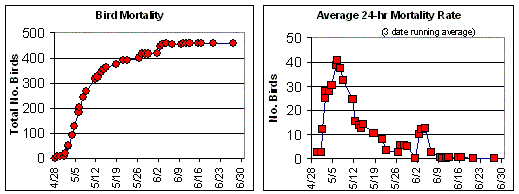Documented and Potential Adverse Impacts from Bouchard Oil Spill
Where the oil comes ashore, and its volume, will define its impacts. Major concerns include:
Shellfish beds
On Monday April 28, the Massachusetts Division of Marine Fisheries closed Buzzards Bay to shellfishing from a line from Angelica Point, Mattapoisett to Nyes Neck, Falmouth, southward to the Rhode Island border. The entire bay was closed April 30. The initial closures were precautionary, and the Massachusetts Division of Fisheries may reopen about 90,000 acres or half the bay on May 22. More heavily oiled areas remain closed.
Go to our Shellfish Impacts page for more information.
Bird Impacts
No. 6 fuel oil can be very adverse to wildlife, and as noted on our No. 6 fuel oil information page, bird mortality is relatively high compared to other oils. The graph shows the initial extent of bird mortality in Buzzards Bay. Two species of Loon account for nearly half of the bird deaths, but 38 species are represented among the birds killed.
Of special interest is the fact that Buzzards Bay has the largest colony of Roseate Terns in North America, a US endangered species. Roseates have been relocating to Ram Island (Mattapoisett) during the last eight years, but Ram Island was a heavily oiled by this spill, and this important habitat remains a key focus of cleanup efforts.
In Buzzards Bay, there are also many breeding sites for the US Endangered Piping Plover, and some of these nesting sites were at risk from the spill.
Go to our bird impacts page for more information on oil impacts to birds

Turtles
The Ridley Turtle, and most other turtles do not arrive until late summer. The USFWS lists the Diamondback Terrapin as at risk.
Mammals
Some harbor seals and seal pups are still found in Buzzards Bay this time of year, which have not yet headed north. They are found along the islands and exposed coast like those in the vicinity of the spill. Some seals were reported oiled in Dartmouth shortly after the spill. Seals are much more likely to survive No. 6 oil than birds.
Swimming beaches
Most sandy beaches have now been cleaned. Rocky and cobble areas are continued to be treated. Beaches are not normally considered open this time of year. Once the beach cleanup is complete, the main issue that may arise after will be the occasional appearance of tiny tar balls on shore, which will be a nuisance if they persist for any length of time. When warmer weather arrives, small amounts of oil may also remobilize. Municipalities will also be concerned about public perception about the oil spill, and whether tourists might be discouraged from visiting because of press reports.
The opening and closing of municipal public and private beaches is under the control of the Board of Health for public health purposes, and Police Departments for safety reasons. Some towns closed certain heavily oiled beaches during cleanup to minimize public exposure to the oil during cleanup operations.
Click here for more information on Buzzards Bay Beaches.
Public Health and Safety Issues
All government officials recommend that the public stay off beaches wherever they see work crews, or accumulation of oil or tar balls. This oil is considered a hazardous material, and you should not attempt your own cleanup. If you get oil on your skin, it is recommended that you use baby oil or mineral oil available in most pharmacies and supermarkets. If you have a cat or dog, it is recommended that you use vegetable oil, because the animals lick their fur, and baby oil should not be consumed. If you believe your pet has been injured, you should seek veterinary services, then contact the Coast Guard.
Damage to salt marshes
Oil can kill salt marsh grass and denude large areas, and remain in salt marsh sediments for decades. Oil can still be smelled in excavated salt marsh peat in Wild Harbor 35 years after the Florida spill. However, in arriving early in the growing season, and because No. 6 tends not to permeate sediments, salt marshes may not be especially damaged by this spill. Some sensitive marshes were also protected by prompt action by municipal first responders who boomed off many areas in the first 48 hours of the spill.
US Fish and Wildlife list of species in Buzzards Bay potentially at risk